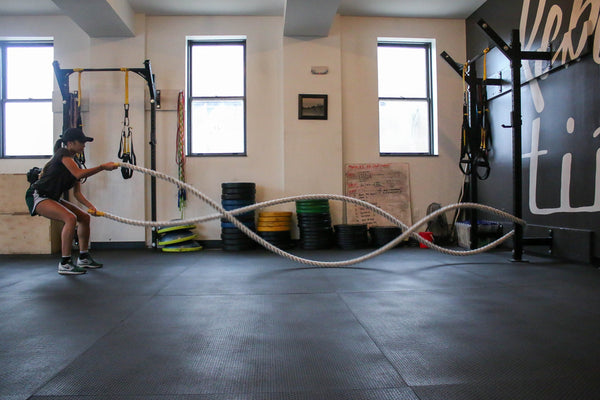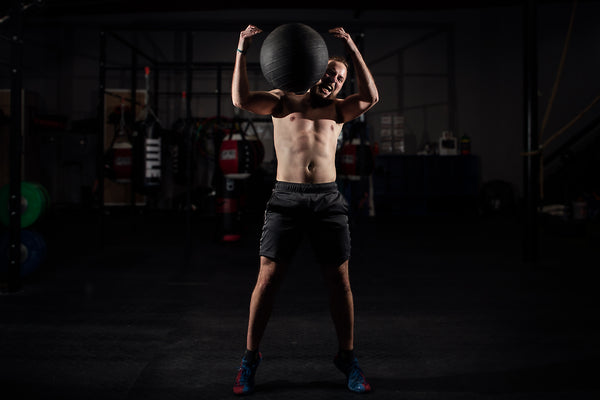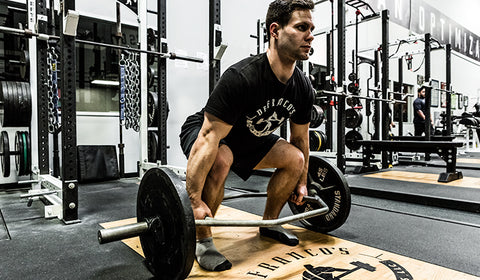- Continue Shopping
- Your Cart is Empty
Design the Ultimate Home Fitness Strategy

Depending on your fitness and workout goals, a home-gym might be good solution for establishing your home fitness strategy. You can start assembling your home gym for under $100. The key to starting a home gym is in how you craft your space and fitness strategy. Whether you’re working out a few days after work or hitting your home gym hard every morning before leaving the house, your success will be tied to establishing a consistent home workout routine. To get you started, here are the most important things you’ll need to take your home fitness progress to the next level.
Gather essential home equipment. First things first. You’ll need to have the right equipment when starting a home gym to make sure you’re working out the right way. If you’re looking for a complete home gym package, then these Rally Fitness equipment packages are a great place to start. Even if you’re not ready for a complete home gym, getting smaller items like medicine and wall balls can be just what you need to start your home gym regime. But, if you’re an experienced fitness buff and are looking for a more intense at-home workout, then adding plyometric boxes to your at-home gym could help you get the most out of your exercise time.

Add in variety to stay motivated. Mix in a healthy dose of cardio and weight training throughout the week to be sure you’re working all of your core areas. Adding weighted ropes and kettlebells to your home gym arsenal are great ways to get a variety of exercises in your daily routine. Yoga and Pilates added in with consistent weight lifting and cross training are great ways to tap into other exercise methods without tiring your body out. Learning to leverage a combination of physical activity can be the best way to maintain an at-home workout routine.

Don’t be afraid to take a day off. Just because the gym is in your home, doesn’t mean that you have to use it every day. It is important to be consistent with your workouts, but it is equally important to give your body the time to recover, heal and repair. To avoid overworking yourself, try writing your weekly workout goals down and keep track of how often and what exercises you do. This way you can be sure that you are not overdoing it with some exercises and not doing enough with others. With a home fitness strategy, “slow and steady” will always pay off big in the long run.
If you’re considering creating your own at-home gym or want to add a few must-have fitness tools to your existing home workout routine, browse Rally Fitness fitness equipment today.New Army Fitness Test OPAT Takes its Cue from CrossFit

The U.S. Army is pilot-testing a new way to measure the fitness of soldiers and it looks a LOT like a CrossFit class. The six-event test measures functional fitness and has no adjustment for gender. They are Occupational Physical Assessment Test, or also known as OPAT.
According to a recent article in The Wall Street Journal, the proposed test known as the “Army Combat Readiness Test” (ACRT), seeks to “encourage more practical physical training and prevent injury in a force frequently deployed around the world. It also reflects a U.S. military where all combat jobs are now open to women: The proposed test would have one set of passing standards, with no adjustments for age or gender.”
Officials who manage the physical training of Army personnel have been concerned about the relative fitness of this fighting force for several years. “When you look at fitness, we’re having some challenges right now,” says Maj. Gen. Malcolm Frost, commanding general of the U.S. Army Center for Initial Military Training. Tens of thousands of soldiers aren’t deployable because of injuries, many caused by poor physical fitness.
The soldiers who belong to the elite forces of the U.S. military such as Navy SEALS and Army Green Berets have a long history with CrossFit training and apparently the physical instructors of the Army have been taking notice of this. It is not a stretch to say that anyone who endures a weekly CrossFit workout – man or woman – would pass this proposed fitness test.
The Current Test is Based on Aerobics
The current Army test got its impetus from the aerobics boom of the 1980’s. This was also a time when many “Cold-War” leaders felt that ground combat was obsolete.
Fitness experts note that this current test, which includes timed push-ups and sit-ups and a two-mile run, and is taken twice a year is only about 40 percent predictive of a soldier’s ability to complete tasks necessary for combat. The proposed ACRT test is about 80 percent predictive.
The article notes that in order to pass the current test, soldiers must score 60 points in each of three categories: push-ups, sit-ups and a timed two-mile run. The test awards points on a sliding scale based on a soldier’s age and gender (except in sit-ups, where the male and female standards are identical). For instance, a 22- to 26-year-old man must do 40 push-ups in two minutes to pass that event. A 22- to 26-year-old woman can pass with 17 push-ups.
The Proposed OPAT is Considerably More Challenging
The proposed test will require both genders to be functionally fit in order to pass. CrossFit athletes will certainly recognize these “events” from their WOD’s.
Event #1 - Dead Lift

Soldiers line up behind rows of barbells loaded with weights ranging from 125 pounds to 425 pounds. Each soldier picks one of the barbells and performs three dead lifts.
Event #2 – A Reverse Throw of a 10-pound Weight
This throw is measured for distance and seems awkward to some soldiers. However, it serves a purpose. It mimics a boosting move that’s “exactly how we get people into buildings,” says Col. Dale Snider in the Journal article. The 49-year-old has been deployed four times to combat zones.
Event #3 – A New Push-Up
The Army notes that the proposed new push-up requires lowering all the way to the ground and extending one’s arms in a T between repetitions. The T push-up is easier to monitor in testing, Army leaders say and is much more difficult to perform.
Event #4 – 250 Meter Shuttle with 90-Pound Sled and Kettlebells

This event, which every CrossFit trainer has included in his/her regimen at one time or another, requires the soldier to alternately sprint, dragging a 90-pound sled and carrying two 40-pound kettlebells. Many in the test have noted that this is one of the toughest as far a muscle fatigue.
Event #5 – The Leg Tuck
This leg tuck, the fifth event in the proposed test, requires lifting knees or thighs to elbows while hanging from a pull-up bar. The article noted that some soldiers struggled to do more than a handful of reps.
Event #6 – The Two-Mile Run
The proposed test ends with a timed two-mile run. This is the only event identical to one in the current test.
Functional Training is Coming…and Soon
According to the Occupational Physical Assessment Test, some of the fighting forces have gotten fat as the Army reports that about 17 percent of its soldiers are obese. This rate has risen (from 13 percent) from the previous year and is about half the overall obesity rate of all U.S. civilians. Clearly, the leaders of the Army feel these numbers are going the wrong way and they plan on doing something about this.
The report noted that change could come as soon as 2018. If adopted, the ACRT would complement or replace the current fitness test in the next few years. “The proposed test is part of a move toward a more comprehensive approach to training and maintaining the Army’s 1 million soldiers. It comes amid high demands on the Army world-wide, a shrinking pool of people eligible for military service and a shift in the civilian fitness industry (such as CrossFit) toward free-weight and functional training.”
Are you in the military service and use CrossFit to keep in shape? Contact us and let us know.
When You're Ready to Explode, Grab the Kettlebells!

One of the most useful pieces of equipment found in a CrossFit gym is the kettlebell – colorfully described by some as a “cannonball with a handle.” This cast-iron or cast steel weight is used to perform ballistic exercises (those which focus on explosiveness) that have the unique advantage of combining cardiovascular, strength and flexibility training.
While the popularity of these weighted balls has only recently taken off, kettlebells have been around since the 1700's. According to several online sources, including Wikipedia, the first kettlebells were used in Russia to weigh crops.
After realizing that their constant lifting and swinging of these weights made the farmers much stronger, they began using them for exercise purposes, leading to the development of a weight-lifting sport known as girevoy sport. The Soviet army used them as part of their physical training and conditioning programs in the 20th century and kettlebells have been used for competition and sports throughout Russia and Europe since the 1940s.
Big Advantage of Kettlebells: Flexibility

While this history of kettlebells is colorful, the real benefit of these weights comes from their amazing flexibility in an exercise program – particularly in a CrossFit environment. Typically, they come in weights of 12 kg., 16 kg. And 24 kg. These weights are chosen based on the participant's strength and flexibility.
According to several online sources, “by their nature, typical kettlebell exercises build strength and endurance, particularly in the lower back, legs, and shoulders, and increase grip strength. The basic movements, such as the swing, snatch, and the clean and jerk, engage the entire body at once, and in a way that mimics real world activities such as shoveling or farm work, an homage to those early kettlebell devotees, the Russian farmers!
How Kettlebells are used in CrossFit Training
As with any piece of exercise equipment, the benefits of using kettlebells in training is directly related to the quality of instruction on their use. There are literally hundreds of exercises which employ these weights and all of them can either help or hurt the athlete using, or misusing them. Needless to say, it is important to obtain professional advice from a qualified trainer before starting to swing these cannonballs around!
Many think of using kettlebells in the same way they would use barbells or dumbbells. While this is intuitive, it’s also wrong. According to CrossFit trainers, kettlebell exercises usually involve large numbers of repetitions. Kettlebell exercises work several muscles simultaneously and may be repeated continuously for several minutes or with short breaks.
This combination makes the exercise partially aerobic and but more similar to the high-intensity interval training of CrossFit, rather than to traditional weight lifting. Because of their high repetitions, kettlebell progression should start out slowly to build muscle endurance, support the joints and prevent injury. When used properly, these weights can improve mobility and range of motion which increasing strength.
The Top Six Kettlebell Exercises
There are probably as many exercises which can be done with kettlebells as there are CrossFit trainers and athletes. The simplicity of their design allows these weights to be deployed in an almost unlimited number of ways. However, no one has unlimited time, so it becomes important to get an opinion on the best exercises – for maximum return on energy (that would be “ROE” for you folks who enjoy acronyms!) expended on a workout.
Scott Iardella, is a strength and conditioning specialist, sports nutritionist, former sports medicine physical therapist, and former competitive bodybuilder with over 30 years of experience. He notes that his passion is helping people of all levels get stronger, improve performance, and discover their physical potential. He's also the creator of "The Rdella Training Podcast."
In a recent post on BodyBuilding.com, Scott picked “The 6 Best Kettlebell Exercises You Need to Do.” Here are the top kettlebell exercises this fitness expert recommends.
EXERCISE 1 THE SWING
“The Russian-style kettlebell swing, in which you project the weight to shoulder-height only, is an insanely effective exercise when executed with proper form. Hip power, hip hinging, and breathing techniques make it incredibly powerful. It's a two-for-one exercise, meaning you're able to combine strength training and cardiovascular conditioning into one efficient movement.
The swing is considered the most powerful kettlebell movement because it represents full-body power, extreme fat loss, and a high level of cardiovascular conditioning. It's also the foundation of all kettlebell ballistic exercises.”
Next up, Scott picked what appears to be a leg exercise, but is in fact a total-body challenge.
EXERCISE 2 THE GOBLET SQUAT
“Squatting is a fundamental movement pattern with many variations. The kettlebell goblet squat isn't just a leg exercise; it's another total-body juggernaut that offers more mobility—the ability to move easily so you can safely train with heavier loads—and improved conditioning.”
The next choice is designed to “bullet-proof your body.”

EXERCISE 3 THE TURKISH GET-UP
“The Turkish get-up is a slow, deliberate movement that's been around for centuries. You start by lying on the floor, then stand up, then lie back down again in a specific sequence of movement transitions. The get-up will help you with functional tasks as well as higher-level exercises. It teaches you to move fluidly, and when you add the external load (a kettlebell), it requires strength, mobility, and skilled movement.”
The fourth exercise chosen by Scott shows the advantages of a kettlebell over a dumbbell.
EXERCISE 4 THE STRICT PRESS
“Once you can do the first three exercises—and have demonstrated appropriate shoulder mobility and stability—the kettlebell press is another exceptional movement to learn. While it looks like an overhead press, it's not just a shoulder exercise, as you use your entire body for maximum pressing power and strength.”
EXERCISE 5 THE CLEAN
Similar to the kettlebell swing, the clean is another explosive exercise for total-body strength and conditioning. The difference here is that the kettlebell finishes in the rack position as opposed to being projected horizontally away from your body.”

EXERCISE 6 THE SNATCH
“Just to be clear, it's nothing like the barbell snatch, except that it begins with the weight in a low position and projects the weight overhead. The kettlebell snatch is physically demanding and technical, but offers outstanding total-body strength and conditioning benefits. It can help transcend athletic performance to new levels, build explosive strength, and forge strong, powerful shoulders.”
What are your favorite kettlebell exercises? Leave us a message and we'll share with our other readers.




